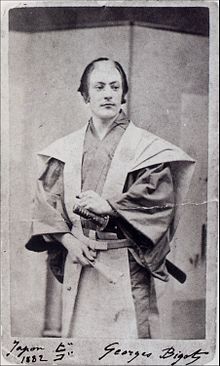 |
| Georges Ferdinand Bigot |
Life of my focus person
Most Japanese people have seen before the picture called “gyou fu no ri (漁夫の利)”. It is one of Bigot’s masterpieces which shows the complicated international situation among Japan, China, Russia and Korea. It is drawn by a famous French cartoonist, Georges Bigot. Bigot was born and raised in Paris and learned at École des Beaux-Arts. After he started working as an illustrator, he was interested in “Japonisme” and decided to come to Japan in 1882. He learned Japanese and lived in Japanese community and frequented red-light districts (yukaku gayoi) to know more about Japan.
Although Bigot is generally known for cartoons in Japan, there are plenty of genre paintings which showed daily life and social conditions faithfully at Meiji period. For example, in a drawing of voting, there are many Japanese men in Western clothes who have Western hairstyles or mustaches. It showed that only high-class men had voting rights and participated in political events. The most significant point of this picture is a man who is wearing Kimono and has a Japanese topknot. His style is really rare in that situation, as can be seen from other men. A cartoon magazine produced and released by Bigot, called “TÔBAÉ”, was published for foreign residents in 1887. It was organized his critics such as the Japanese government. At present, those works are really important historical materials.
Summary of discussion
Q1. What do you think / how do you feel about his drawings?
Q2. Imagine if you were Bigot, what would you draw about present Japan?
Initially, listeners were impressed by the works especially cartoons for the first question. They had same opinions as mine that the pictures explained as they are. I thought that they have already known his works so it was easy to think. Although the second question was a little bit tricky for them, we could share some ideas at the end of the discussion. Most of them talked about Japanese problems such as Fukushima problems, the relationships between Japan and the U.S. and so on. On the other hand, only few ideas about our present daily lives were shared. I thought that it was not easy for us to see ourselves as others see us.
Reflection on person and project
Through this project, I learned that Bigot had really critical eyes. At first, I did not know that he drew various works as well as cartoons. For example, there are “Japanese” who he admired in his genre pictures. Also, they showed real daily lives in Meiji period. Therefore, I realized again how he saw Japan clearly, calmly and carefully. I am surprised that we are in the same situation of his works. In fact, there are plenty of types of media and they are playing a major role in the sharing of information. However, the government is still strict about them even though Japanese people want to know the truth. I think the picture shows us that it is significant to have various “eyes” on your mind.
References
Shimizu, Isao. 2001. Bigot ga mita Nihonjin. Tokyo: Kodansha
Shimizu, Isao. 2006. Bigot ga mita Meiji Nppon. Tokyo: Kodansha
No comments:
Post a Comment